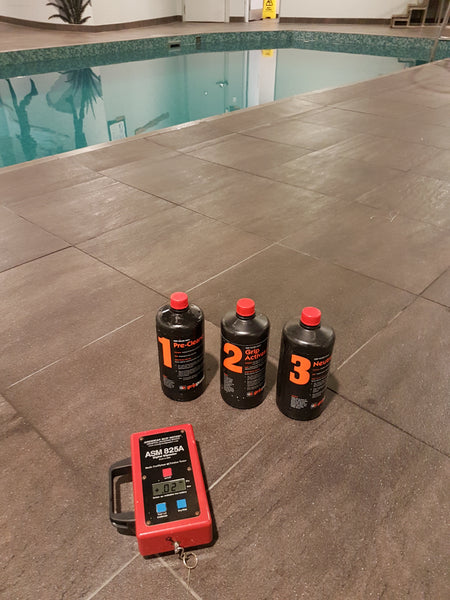
Grip Guard anti-slip treatment alters the porosity or absorbency of the topmost surface pore structure of tiles, stone and other mineral surfaces in a controlled manner that dramatically improves the slip resistance of the floor when wet.
Grip Guard anti-slip treatment is customised on site by our experts to suit your specific floor type and mineral make up. The treatment microscopically alters the porosity and absorbency of the topmost surface pore structure, channelling the water away from beneath your feet.
This treatment is a controlled application which dramatically increases the grip of floors for bare feet, shoes and all kinds of pneumatic and solid wheel tyres.
When surfaces become wet or moist, Grip Guard anti-slip treatment is activated and immediately makes those surfaces skid and slip resistant. It is suitable for all stone-based floor surfaces including: ceramic and porcelain tiles, terrazzo, marble, granite, concrete and aggregate, on both indoor and outdoor flooring.
No visible change
The special blend of chemicals finds its way into the existing pore structure and modifies the depth of these pores. Unlike etching processes that eat into the surface itself and roughen the texture, the treatment leaves most surfaces looking like the did before treatment and feeling the same when dry.
No special maintenance
Unlike surface coating and mats which require regular maintenance and can quickly look unsightly, Grip Guard requires no special maintenance. Treated floors can be cleaned as per normal and the treatment cannot be worn away by pedestrian traffic
Slip Resistance Warranty
We provide you with a warranty that documents the slip resistance of the floor surface both prior to and following treatment, the area's treated as well as methods undertaken.
No disruptions
The application can usually be carried out during business hours with little or no disruption to normal business procedures. Floors can be walked on immediately after completion.
Verified Slip Resistance
If required, independent NATA certified slip testing can be arranged for customers requiring a compliance certificate.
How it Works
#1: Surface Preparation
The first stage of the treatment is formulated to prepare floors removing dirt and grease, cleaning grout of contaminants and, in some cases, removing build up of grease or other ingrained foreign materials. This step ensures that the floor surface is prepared for the Grip Activator.
#2: Grip Activator
The second stage modifies the floor to enhance slip resistance. Each surface is tested to determine the mixing proportions and timing. Grip Activator is then applied to the prepared floor surface using a low pressure sprayer until the desired slip resistance is achieved.
#3: Neutralization
During stage three, the Grip Guard Activator is instantly neutralized at a pre-determined period of time required to reach the desired slip resistance. The neutralizer is sprayed onto the surface and later removed using a wet vacuum, squeegee or mop.
After Care
As Grip Guard anti-slip treatment actually modifies the floor rather than coating it, slip resistance is retained as long as the actual floor surface is not worn away by heavy vehicular traffic. However, it is essential that floors are kept clean and free of debris and contaminants. In kitchen applications, a high quality degreaser should be used regularly to eliminate grease and fats that can build up on the surface and create a barrier between the treated surface and the foot.







